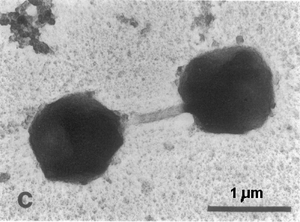Hyperthermus butylicus
Welcome to MicrobeWiki
Microbial Biorealm * Viral Biorealm * Microbial World News * Microbial Mythology
MicrobeWiki is a free wiki resource on microbes and microbiology, edited by students and monitored by microbiologists at Kenyon College. We invite you to use our Microbe Wiki to study the microbial world with us. You are encouraged to add information, after registering a free account.
Educators: You may assign MicrobeWiki page creation and editing as projects for your students. We create a template page for your assignment, which you may edit to meet your needs. See for example the pages created by Dr. Kirk Bartholomew's microbiology class at Sacred Heart University. Your students receive individual passwords. Assessment and "grading" are up to you; after your class is over, we review pages for our standards. Students of all levels, from first-year to graduate students, have contributed pages to our site.
MicrobeWiki includes these modules:
Microbial Biorealm: encylopedia of bacteria, archaea and eukaryotic microbes. See also Taxonomy Index.
Viral Biorealm: encyclopedia of viruses of animals and plants, and bacteriophages. See also Taxonomy Index.
Microbial World News: highlights of microbiology in the news.
Microbial Mythology: common errors and controversies in microbiology.
Managing Editor
Daniel Barich '05 A Microbial Biorealm page on the genus Hyperthermus butylicus

Classification
Higher order taxa
Archaea; Crenarchaeota; Thermoprotei; Desulfurococcales; Pyrodictiaceae
Species
Hyperthermus butylicus
|
NCBI: Taxonomy Genome |
Description and significance
Hyperthermus butylicus is under Archaeal kingdom Crenarchaeota. This aquatic anaerobe is found near the coast of the island of São Miguel, Azores. Found in temperatures as high as 112C°, H. butylicus has a broad temperature optimum of 95 to 106 C°.
Genome structure
The genome of Hyperthermus is currently being sequenced by the group from the University of Copenhagen. The G + C content of the DNA is around 55%.
Cell structure and metabolism
The cells of Hyperthermus are irregular spherical (around 1.5 µm in diameter) shape with edges between partially flattened surfaces. The ones that grow in higher temperature often contain vacuoles within their cytoplasm, sometimes immediately below the S layer. The archaeon utilizes peptide mixtures, obtained by various hydrolysis procedures (eg, Tryptone, Trypticase, Merck peptone from casein, gelatin, and a chymotryptic digest of casein) as carbon and energy sources. No growth has been observed with starch, maltose, sucrose, lactose, glucose, galactose, ribose, lactic acid, lactic acid ethylester, glyoxylate, pyruvate, oxalate, fumarate, maleate, malate, malonate, and formate. Hyperthermus is the first archaebacterium for which fermentation products have been identified. Its H2S formation results in increased growth capacity without a major change in the nature of the products, except that it allows utilization of peptide-bound nitrogen. Therefore, this could possibly act as an accessory means to generate ATP.
Ecology
The strains of Hyperthermus butylicus were isolated from the sea floor of a hot, solfataric babitat on the coast of São Miguel Island in Azores, Portugal. With its ability to live at the temperature of 106°C, it is one of the most thermophilic archaea isolated so far. Also, interestingly, despite its being found in a marine environment,
References
Kenyon Student Editors, 2002-2007
Ryo Tashiro '09, Molly Schlemmer '08, Shrochis Karki '09, Drew Taber3, Allison Whipple '06, Zeva Levine1, Laura Damon-Moore1, Ariel Kahrl2, Hannah Sacks '08, Michael Stulberg '05, Casey M. Smith '06, and Shana Scogin '07
Advisor: Joan Slonczewski, Biology Dept, Kenyon College
Guest editors from 1Beloit, 2Oberlin, and 3Columbia Union College.
Funded by HHMI awards to Kenyon College, 2000, 2004.
Copyright notice. Readers may view, browse, and/or download material for
noncommercial personal purposes. Please credit our site for use. Materials on our site obtained with permission from other sources require permission from those sources
for further reproduction.
Disclaimer. Information on this site is provided solely for educational purposes. Medical questions should be referred to a physician.
